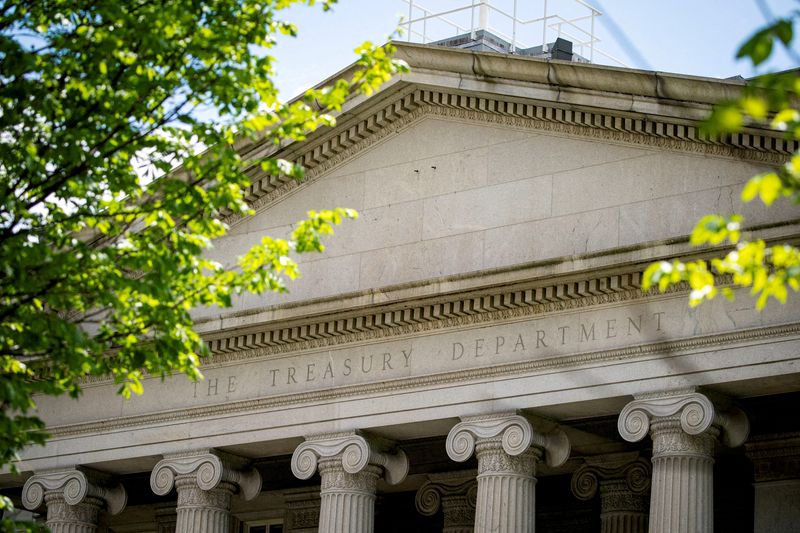Column-US Treasury plays cat and mouse with debt sales :Mike Dolan
2024.08.28 02:25
By Mike Dolan
LONDON (Reuters) – The U.S. Treasury has a lot of debt to place in the next year, but its active management of the maturity profile shows why the oft-heralded U.S. debt “crisis” is unlikely to occur anytime soon.
Treasury funding math currently is quite daunting, with more than half a trillion dollars of bills and bonds under the hammer this week alone.
But almost three-quarters of this week’s deluge is in bills, which mature in 12 months or less, and these will roll over at progressively lower rates if U.S. interest rates decline as expected.
While huge weekly Treasury sales are by now familiar, many investors continue to circulate notes expressing concern about the mounting levels of government debt that need to find willing buyers.
Torsten Slok, the chief economist at Apollo Global Management (NYSE:), is the latest to warn of potential danger ahead with his “Top 10” list of Treasury factoids.
Slok notes that $9 trillion of government debt is maturing over the next year, debt servicing costs have hit 12% of government outlays, trillion-dollar-plus deficits are projected over the next decade, and the debt/GDP ratio is expected to double to 200% by mid-century.
His conclusion is simple: Watch out for bumpy auctions, possible credit rating downgrades, and the persistent threat that long-term bond investors will begin to demand a hefty “term premium” to hold long-dated Treasuries.
But by front-loading the maturity profile of the debt, the Treasury is revealing one of its main tools to circumvent a debt crunch over the coming year or more.
Even though the weighted average maturity of the entire marketable debt stock is still above pre-pandemic levels at close to six years, bills maturing in one year or less make up 22% of the total – well up from the 10%-15% seen both 18 months ago and typical for much of the decade before COVID-19 hit.
With policy rates currently more than 5%, that short-term issuance will be costly.
But the picture changes considerably if the Federal Reserve moves into rate-cutting mode next month and lops more than 200 basis points off rates over the next year, as the futures markets currently expect.
BUILDING BILLS
Does this mean the Treasury is deliberately distorting the U.S. government debt market? Analysts at CrossBorder Capital argue the Treasury is doing just that through a policy of “active duration management” (ADM) designed to suppress yields.
In a piece headlined “US Treasury Bribes World’s Smartest Investor,” CrossBorder models what that bill-heavy maturity profile might mean for debt tenors currently receiving less attention, such as the benchmark 10-year Treasury note.
The analysts compare the yield on the latter with the much-higher yield on equivalent U.S. mortgage-linked bonds, adjusted for interest rate sensitivity and the related “convexity.”
Their model shows a whopping 100-basis-point-plus gap between the two, which they suggest is wholly due to this unofficial ADM policy.
CrossBorder says a funding discount of that size knocks a full 35 percentage points off the U.S. 2050 debt/GDP ratio forecast.
So win-win? Perhaps not entirely.
The negatives are less obvious, but no less meaningful.
If 10-year yields are suppressed to the degree suggested, then that’s one reason why the shape of the yield curve has been persistently inverted for more than two years without the recession many say that predicts actually unfolding.
But there are costs to losing such a useful tool in forecasting the future course of the economy and inflation.
Also, further reduction in the average maturity profile of the entire debt stock from here makes rollover risk a greater concern. Periodic “accidents,” such as debt ceiling rows or temporary default threats in the bill market, could have a disproportionate impact if exposure to bills keeps rising.
And even though continuing to jam the bill markets with new paper may reduce debt servicing costs in the near term, what happens when the Fed cycle turns again or the economy truly is in a new world in which higher inflation and elevated rates persist?
That risk is especially pertinent given current political realities. Absent a shift in fiscal policy over the coming years, the U.S. debt profile will eventually require some painful adjustments.
And, ironically, the lack of market ructions in the interim could actually lessen the chance of political action to rein in the deficits and debt, which will only compound the problem.
But what’s also clear is government debt managers have multiple tools and sleights of hand to help them navigate this current period without generating the sort of crisis so many forecast.

Whether such moves are just temporary stopgaps is another question. But, given recent history, it would seem dangerous to bet that the Treasury and Fed will fail to keep this particular show playing for the foreseeable future.
The opinions expressed here are those of the author, a columnist for Reuters.
(by Mike Dolan; Editing by Paul Simao)








